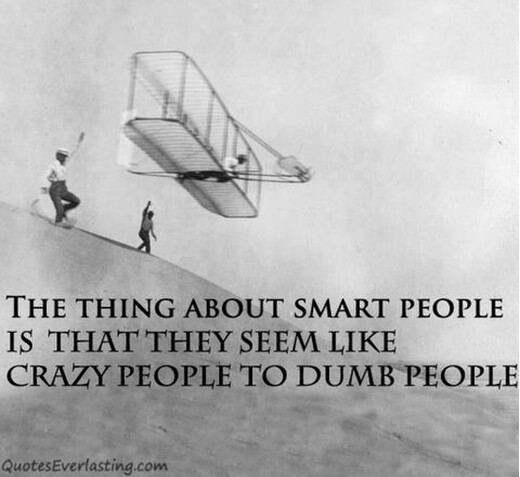Not too long ago, I  watching a series on PBS about the Seven Deadly Sins (Wrath, Pride, Envy, Greed, Sloth, Lust and Gluttony) and things started churning in my mind. So I decided to list my “Seven Deadly Sins of Marketing,” given what I continue to see taking place within marketing and marketing departments across all different industries.
watching a series on PBS about the Seven Deadly Sins (Wrath, Pride, Envy, Greed, Sloth, Lust and Gluttony) and things started churning in my mind. So I decided to list my “Seven Deadly Sins of Marketing,” given what I continue to see taking place within marketing and marketing departments across all different industries.
Guessing
In the Dilbert cartoon series, Dilbert says that “marketing is just liquor and guessing.” Funny…but as we know, a bit simplistic. Yet, too many companies assume that there is absolutely no need to substantiate their beliefs about the marketplace, about what their prospects want, about why their customers are buying, about what people think of their brand, about most anything having to do with those whom they want to purchase their products or services. Generally the thinking is that no one can know the marketplace as well as the company and the market will accept whatever you offer. Guess (pun intended) how that turned out for Kodak, Borders Books, TWA, and certainly some companies in your own industry! Ask yourself, when was the last time that your company committed the time and resources to do some marketing research…qualitative, quantitative, ethnographic, etc. And do it right.
Marketing by Committee (Indecisiveness)
I’m not sure why, but when it comes to marketing, everyone seems to have a say. Partners, staff, associates, spouses, and the janitor all want to give their two-cents. How about an accounting committee to help figure out where the credits and debits are posted? Or an office supply committee to pick out the colors of pens you order? Many executives forget that great marketing is not about what they like. Great marketing is about what works.
Committees, by nature, are full of compromises so solutions are usually watered down versions that will wind up doing little or nothing to accomplish your growth goals. Marketing by committee leads to lots of bad ideas and poorly thought out plans. Instead of bold strokes from the marketing brush, you get a sea of beige. And then it doesn’t work. Who would have thunk it! The solution is to decide on objectives and budget, and then write a marketing plan. Once the plan is approved, ONE person gets appointed within the organization to take on the role as “the decider.” Empower him or her to make all the courageous decisions required to position your company to dominate your category.
Inconsistency
When different aspects of your marketing messages don’t reinforce each other, the inconsistencies alienate prospects and current customers. Inconsistent marketing distorts clear expectations, makes potential customers unsure of the characteristics of your products and creates unhappy customers who don’t get what they expect. These inconsistencies affect businesses by reducing both initial sales to consumers as well as repeat sales from dissatisfied customers. Also, be consistent with your marketing plan. Don’t stop running an ad, for instance, just because the first insertion didn’t ring your phone off the hook. Give your campaign time to work, but you also need to know when a change in direction is a good idea. Remember, people are not paying that much attention to you, but when they do, it helps if the message you’re saying now is similar to the message that they heard the last time.
Complacency
It’s out there right now. Lurking in the shadows of your success. It is the silent business killer that strikes without warning and can bring even the biggest and the brightest companies to their knees. What is this hidden terror? Complacency. We all know it better as the dreaded “status-quo.” It generally takes the form of “whatever we did last year.” Except, things change. Your competitors are changing things up. Your customer’s needs are changing. The marketplace is changing. A few things to avoid complacency: Keep looking in your rearview mirror to see what your competitors are doing. Listen to new ideas as the next big idea may not come out of your own mouth. And, strive to always do better even before you are forced to react to a competitor’s challenge.
Lack of Focus
Okay, so after reading articles by “experts” about how you should have a customer engagement program in place (so you can be more “customer-centric”), you’ve put your company on LinkedIn, YouTube, Facebook, Twitter, Google+, and Pinterest. Heck, you’re even ready to go when the next big social media platform launches. You’ve got your product literature online, and your Web site has a blog and videos. Not to mention all the offline activities ranging from tradeshow activities to advertising to PR, etc. But why did you believe you needed to be in ALL of these social media locations in the first place, and, just as importantly, who is making sure that all of these activities work together?
Narcissism
It’s ridiculous that I have to say this but the memo has not reached the desk of many marketers, so here goes: “It’s not about what your company wants to say but rather about what the customer wants to hear.” (I feel better having said it.) Look, if you want to market based on your personal preferences without regard for what works best with your prospects, that’s your prerogative. But I’d suggest that your company’s marketing not be so self-absorbed. Remember, you don’t buy from you, others buy from you and they don’t care about your business and your troubles nearly as much as you do. Most people are tuned into Radio Station W.I.I.F.M. —“What’s In It For Me!” If your marketing message is all about you, then your customers won’t notice what you’re saying. Please begin to “tune” into your customers, find out what they really want and focus your message on them.
Confusion
Maybe, just maybe, the deadliest marketing sin of all is not having one over-arching marketing strategy – and insuring its implementation through all your tactics. Executing marketing tactics without having a well-developed integrated strategy is like leaving your roadmap tools at home and taking off on the drive without considering if you’ve chosen the right road. You wouldn’t haphazardly set off on an important trip in your car so why let it happen with regard to your company’s marketing activities. It’s easy to start with the “how” but if you haven’t identified the “what,” you may find yourself spending a lot of time executing tactics that don’t take you where you want to go and in so doing, you’ll be wasting time, resources and losing out on sales-producing opportunities. What is needed is one single integrated strategy that looks across all delivery platforms whether online or offline, print, broadcast, or mobile. Your customers don’t have an online self and offline self and neither should you. Think holistically about all your marketing initiatives.
Yes, there are more Deadly Sins that I could have talked about, like trying to be a “do-it-yourselfer,” or not measuring your activities, or saving yourself into bankruptcy, but the above are the Seven Marketing Sins I rank topmost. Now, let us all go out and to the best of our ability, sin no more.
####
Rolf Gutknecht is vice president, director of account services for LA ads. To discuss your thoughts with Rolf on this blog or any marketing matters, email via this link, or visit www.LAadsMarketing.com. You can also connect with Rolf on LinkedIn.
 Retail pioneer John Wanamaker was famously quoted “Half the money I spend on advertising is wasted; the trouble is I don’t know which half.” It’s the dilemma of marketers whether they’re in retail or manufacturing, whether they’re spending tens of million dollars a year on marketing or just ten thousand.
Retail pioneer John Wanamaker was famously quoted “Half the money I spend on advertising is wasted; the trouble is I don’t know which half.” It’s the dilemma of marketers whether they’re in retail or manufacturing, whether they’re spending tens of million dollars a year on marketing or just ten thousand.
As catchy as the quote may be, it’s not really that difficult to parse the answer. After all, there are only two fundamental components to advertising: what you have to say and where (or to whom) you say it. The half most advertisers spend the bulk of their money on is the “where,” which really means the media. So when the advertising results in a resounding thud, all that expensive media gets the blame. I can’t tell you how many times I hear a new client tell us “I’ve run in radio and it doesn’t work” or “We don’t use billboards, that’s a waste of money.”
Gentle readers, here’s the simple truth: if the message is not compelling, you can quadruple your advertising spend and still get dismal results.
Let’s put it in human terms. The guy who’s popular at a big party will be popular at a small party. The guy who’s a bore at black tie gala will put people to sleep standing at a car wash. So, in short, it’s primarily all in the messaging. What you choose to do at this juncture is what will affect everything that follows. So here are some ways to think about making both halves of your advertising dollars work for you:
So, in essence, getting your money’s worth starts at the very beginning, not at the end. Putting the bulk of your focus on messaging, rather than media, will be much more rewarding. Oh, and while we’re at it, D-I-Y is pervasive – but hardly ever persuasive! Try this on for size: open up 5 trade or consumer magazines and tag or cutout 10 ads that stop you in your tracks… ones that convey a strong value proposition, ones that you wish your firm had done! My completely biased but nevertheless absolutely accurate guess is that all 90% of those ads you clipped out were created by a marketing or advertising agency.
Also, don’t substitute hard-core strategic homework for a clever headline. And don’t think that the media selection is wrong when the creative you’re placing in it is what’s sending your audience running in the wrong direction. (I’ve seen humble bus benches create insanely great response when used creatively.)
There. Now you know which half of your advertising needs more of your love.
####
Rolf Gutknecht is vice president, director of account services for LA ads. To discuss your thoughts with Rolf on this blog or any marketing matters, email via this link, or visit www.LAadsMarketing.com. You can also connect with Rolf on LinkedIn.

We’ve all had an experience with those finance/accounting types who drive us crazy, requiring that any and all marketing initiatives be measured and that we justify our expenses. More times than not, we spend lots of time trying to come up with metrics that will satisfy them. But in doing so, as marketers we sometimes come up short in the mind of the finance guys and then you hear things like: “Marketing just doesn’t understand numbers,” or “when campaign results don’t stack up, admit it and then figure out how to move forward.” Alternatively, Marketing Directors, say things like: “Finance doesn’t know what good marketing can do for our brand,” “Marketing is not just about spreadsheets,” or “When was the last time they went out on a sales call?” Yup, we’ve heard these and other responses on more than one occasion.
With all due respect, I’d like to put it out there that maybe a majority of the problem doesn’t always start and end with the financial folks. How’s that? Well, sometimes, it seems as if the marketing people and the finance people are just talking two different languages. Certainly, each has a different “world view” of business. For example…
We talk a lot about strategy and forget about tactics.
Because of the sexiness associated with Strategy, we marketers like to call almost everything we do “strategic.” In fact, almost every component of marketing now seems to have its own strategy: Online strategy. Social media strategy. PR strategy. CRM strategy. And it just keeps on going. Well, for the folks in finance & accounting, there’s a critical difference between a strategy and a tactic! The word “tactics” in their minds is immediate, all about bringing in income sooner rather than later. “Strategy” to them is more about a longer-term income stream that won’t likely show up on next quarter’s P&L statement. So, if tactics and strategy play different roles in ROI, and all we do is stuff that’s “strategic,” maybe the CFO is right to wonder if what we do will ever positively affect the bottom line? And when?
More times than we should, we talk high expectations. And then deliver less than startling results.
Too often, marketers jump on the latest fad and technological ‘’silver bullet’ and declare that this is the answer we’ve all been waiting for. Some people in marketing are too quick to buy into what others are doing, even if it doesn’t actually makes sense for your industry or company. And there are some chasing the rainbow looking for the pot of gold. For example, five years ago, there were people writing books, blogs and commentaries telling everyone who would listen that because of the internet, brick and mortar businesses would decline and that we’d all be working virtually by now. How has that turned out?! Hmmm. I’m glad I don’t have to eat those words. I’m not suggesting that as marketers we sandbag the anticipated results for any marketing effort or campaign we’re launching, but we do need to watch just how rosy a picture gets painted, because the numbers people will hold us accountable.
We spend almost no time developing relationships with “those people in Finance”.
When I started in the Marketing Department of a large Fortune 100 organization, the first piece of advice I received from my boss (who had my job before being promoted) was “go and make friends with the people in Finance.” “Making friends” were the key words because that’s when things start to happen. It’s amazing when marketing and finance people begin having lunch together and start to understand how each department sees the world. When was the last time you saw marketing people explain the rationale behind their plans, develop some semblance of what the company can expect in the ways of meaningful metrics, give details and defend the realities behind the timelines, or justify the amount of work it takes to make a concept real and attractive in the marketplace? In short, by figuring how to work with one another, communicate with one another, and then look for ways to help one another, everyone can feel better with what the Marketing Department is doing.
So, do marketers need to talk the language of finance? Or do finance people need to become more fluent in marketing? Or is it somewhere in between? And how do we get there? Well, how does this sound as a starting point. When we marketers talk to our customers and prospects, we’re supposed to speak to them in a language that they understand – one that’s meaningful and beneficial to them. Maybe we should try talking to those Finance People the same way.
####
Rolf Gutknecht is vice president, director of account services for LA ads. To discuss your thoughts with Rolf on this blog or any marketing matters, email via this link, or visit www.LAadsMarketing.com. You can also connect with Rolf on LinkedIn.
 As a partner in a thriving marketing firm that targets companies with $20-$100 million in annual sales, one of my responsibilities is that of business development. While I learn something in each conversation with people in marketing leadership positions, many times after I hang up the phone, I say to myself, “there’s another one who’s losing sales to their competitors!” Mainly that’s because these folks have adopted some misconception about marketing as the “truth” that they can’t and won’t let go of no matter what. So while they say they’d like their sales to be stronger, their year-over-year sales won’t change much or, in some cases, will decrease from one year to the next.
As a partner in a thriving marketing firm that targets companies with $20-$100 million in annual sales, one of my responsibilities is that of business development. While I learn something in each conversation with people in marketing leadership positions, many times after I hang up the phone, I say to myself, “there’s another one who’s losing sales to their competitors!” Mainly that’s because these folks have adopted some misconception about marketing as the “truth” that they can’t and won’t let go of no matter what. So while they say they’d like their sales to be stronger, their year-over-year sales won’t change much or, in some cases, will decrease from one year to the next.
So, let’s do a quick run-through of 5 most common fallacies that I hear. Hopefully none of these sound as familiar to you as they do to me.
I can grow my sales and “share of pie” with a smaller budget than my competitors
When I hear this, it generally implies two things to me: 1) Either your competitors are wasting a big portion of their marketing budget on initiatives or messaging that doesn’t connect with the customers or, 2) your marketing partners are fantastic because they’re willing to work for less than the average market price in order to do the wonderful work they do…which I have a hard time believing is the case. Oh, and then let’s not forget about the inability of these companies to track how much money the competitor is actually (over) spending on marketing.
The reality is this: if your company is spending a good deal less than the competition, you’re probably not making any significant gains in market share. Yes, there might be a competitor that’s overspending, but my experience working with companies from the Fortune 100 to small mom-and-pops is that you don’t pose a serious competitive threat unless your marketing budget is in the same ballpark with your competition….it’s just one of those “marketing truths.”
Marketing’s role is to generate new business
You’ll get no argument from me that one of the jobs of marketing is to generate new business, directly or indirectly. But just as important, marketing’s role is to make existing customers come back for more, that is making customers loyal to the brand. Many businesses are so focused on attracting new customers that they tend to ignore – or even walk away from – the existing ones. Yes, new customers are constantly needed, but truly successful companies prosper on their ability to retain the customers they’ve already acquired. The reason is simple: finding new customers is expensive and time-consuming. Let the following research statistics wash over you….
New business is always good but don’t forget who’s paying the bills.
We’re looking to be more visible with our customers because it leads to better engagement
Reaching the right balance between quality and frequency of the message requires careful consideration. There is a common belief among some that the more we communicate with our customers, the more “engaged” they will become. In fact, not knowing when to “zip it” is a classic marketing mistake that too many marketing people make. If marketing is about building relationships with customers, over-marketing is the best way to kill the relationship and send the customer or prospect heading for the door. A social engagement study entitled “The Social Breakup” prepared by ExactTarget, provides clear evidence of what happens to customer relationships when the marketer comes on too strong:
Guess the biggest reason people break up with companies? (Drum roll)…Too much marketing. The study showed that:
In short, increasing the frequency of communication shouldn’t be your marketing goal. Constantly improving content quality should be.
We don’t need a marketing firm because we can do it in-house for less
It’s the #1 thing I hear the most. A survey conducted by American Express Canada shows that “84% of small business owners say branding is important to overall business success, but only 14% hire third-party experts to help with branding.” I am not surprised by the results, and I can only guess the reasons: agency expense, the desire to have full control over the creative process, poor prior experience with an agency, or possibly the ability to make changes faster on one’s own. So, instead of looking for an outside marketing partner, many companies decide to hire a “marketing person” who wears many hats: graphic designer, social media specialist, copywriter, etc. Let’s be honest, no marketer can be a specialist in everything, unless the company is willing to cut corners on how it presents itself to the world.
Now please understand, I’m not trying to bash the in-house marketing department as there are a lot of smart and talented people out there working for companies. Rather, my point is this: the right outside marketing partner will bring a focus to the marketing initiatives or project, resulting in faster execution time; will come in with an original point of view – more in line with how your customer will interpret the messaging; develop much fresher creative (no “vanilla” wallpaper stuff that gets passed over, and; deliver a much higher level of production quality. Try this on for size: open up 5 trade or consumer magazines and tag or cutout 10 ads that stop you in your tracks… ones that convey a strong value proposition, ones that you wish your firm had done! My completely biased but nevertheless absolutely accurate guess is that all 90% of those ads you clipped out were created by a marketing or advertising agency.
We’re looking for something beyond traditional marketing because that kind of advertising is dead
The internet is chock full of advice on how your company should abandon traditional “old school” communication methods and make the switch to online. It would seem like TV, print ads, billboards, and radio are dying and not worth considering in the overall communication strategy. Yet, research (and lots of it) say this is an incorrect assumption. I think we can agree that the best marketing communication strategy uses a mix of offline and online tactics to reach the target audience. (Do yourself a favor and visit www.marketingcharts.com and subscribe –it’s free. Here you’ll get daily research updates on a wide range of topics including how traditional channels are preferred over digital depending on the audience.)
While it’s true that more money is shifting towards digital, the traditional marketing channels are still heavily required in many business environments. In fact, when Google started getting serious competition, they started running…wait for it…TV ads! When Dollar Shave Club saw that their growth was limited by only online marketing, they started using those old, traditional channels that have in turn made them a rising star company. When there’s a product launch, a sale or just about any other occasion where you need to reach a mass audience quickly and effectively, there’s still no substitute for paid media…and even the dot-coms know it. Think about this, in 2014, the average cost of a 30-second Super Bowl ad was more than $4 million. No CEO or Marketing Director would ever approve such a budget without taking ROI into account, right?
So as I noted earlier, hopefully none of these sound familiar to you. But if on the other hand you’ve heard or said one of these things in the past, know that a lot of confusion, frustration and unrealistic expectations can be eliminated by seeing the world through a different set of lenses.
####
Rolf Gutknecht is vice president, director of account services for LA ads. To discuss your thoughts with Rolf on this blog or any marketing matters, email via this link, or visit www.LAadsMarketing.com. You can also connect with Rolf on LinkedIn.
As we all know, Pinterest and Instagram have become staples on the social media scene. The right visuals (from photos to quotes to inspirational messages) have great appeal and serve as motivation for many. With that in mind, here are some interesting visuals coupled with some content concerning marketing issues that face marketing teams almost daily as they work towards creating the change in the way people use and interact with their company’s products or services. Short, sweet and fun. Click away! 
The average attention span today is roughly 9 seconds…like that of a goldfish. Nine seconds to communicate a message, earn a little bit of loyalty, build a little bit of trust so you can continue the conversation before your customer starts getting distracted! So what could you possibly say in that time or less to get someone’s attention? It starts with presenting your message in clever and unexpected ways. It grabs people’s attention and has them focusing on the message and not thinking about the other stuff that could come into their mind. They’re engaged and captivated. In doing so, it allows you to persuade them, get them to trust you, get them to believe you, get them to want to connect with you. A shift in perspective from speaking about yourself to speaking from the audience’s point of view can be remarkably effective. Witness a beautiful commercial for a British online content company featuring a blind man whose original cardboard sign talks about himself, “I’m blind. Please help.” But when a caring passer-by changes the words to be more audience-focused, something powerful happens. The symbolism is powerful. To read more, click here.
Social media as a pathway to sales is almost certainly not going to work to the degree you want. There…I said it. While social media can be a valuable marketing tool, it’s not magic and it cannot and won’t replace everything that came before it. There’s no quick success and very few programs break through. Coca-Cola says it can find no correlation between “buzz” on Twitter and actual unit sales. Nissan admits it has no idea if social media helps it shift cars. MasterCard can’t tie its social investment to revenues. Don’t take my word for this. Go online and do your own research and see for yourself. In fact, there remains little evidence social media does anything to boost brands’ bottom lines. So then why use social media at all? The reason is that it is an impactful vehicle for empowering advocacy and we know that’s extremely important for brand health and profitability. Social media, if done right, can capitalize on what brand equity your company has already built up. To read more, click here.
 When was the last time you/your marketing team asked the question “I wonder what would happen if we ________.”Crazy ideas have changed the way we go about living our lives. Knowing this, why is it that many marketers still don’t trust the crazy idea when it shows up unexpectedly especially, since crazy ideas, not safe ideas, are the game changers that propel companies forward? In today’s competitive, me-too world, if your product isn’t a legitimate leader in a category, it’s certainly a far better choice to come up with a new value story around your own product or service rather than trying to compete price-wise on the value that was generated by a competitor. You might want to be thinking about a crazy idea that will create a new meaning around your brand. Embrace that mindset so much so that the next time an idea is presented by your marketing department and someone outside of that department says “That’s a crazy idea,” you’ll say, “Thanks, we love it as well!” To read more, click here.
When was the last time you/your marketing team asked the question “I wonder what would happen if we ________.”Crazy ideas have changed the way we go about living our lives. Knowing this, why is it that many marketers still don’t trust the crazy idea when it shows up unexpectedly especially, since crazy ideas, not safe ideas, are the game changers that propel companies forward? In today’s competitive, me-too world, if your product isn’t a legitimate leader in a category, it’s certainly a far better choice to come up with a new value story around your own product or service rather than trying to compete price-wise on the value that was generated by a competitor. You might want to be thinking about a crazy idea that will create a new meaning around your brand. Embrace that mindset so much so that the next time an idea is presented by your marketing department and someone outside of that department says “That’s a crazy idea,” you’ll say, “Thanks, we love it as well!” To read more, click here.
If you want to have passionate customers and dedicated partners, you must first inspire strong responses. But as you attract fans, you’re also bound to get the critics or “Haters.” It’s OK to have some folks (not too many, though) who will not like your brand. The undeniable reality is that if you’re not eliciting a negative response from someone somewhere, then you’re probably not that fascinating to anyone. Think about it, even Apple has Haters as does Starbucks and it hasn’t hurt them. Alternatively, you have the advocates, evangelists, loyalist…the Lovers. They don’t just buy your product or service, they also accept price increases and forgive occasional “issues.” They’re loyal and not just buying your products for price or utility. In the middle are the Lukewarmers. They have a really bad habit of not caring. They won’t buy your product unless it’s the cheapest or most convenient option which means they’re only buying you until a cheaper or more convenient alternative comes around. In today’s marketplace, this middle ground is death!! Not caring is not buying. Not caring is inaction. The world is not changed by people who sort of care or don’t care at all. Stop focusing on the Lukewarmer. Start by having your marketing and advertising be imaginative, original and fresh. To read more, click here.
Having dealt with all sorts of companies and people, I believe the Number One reason for boring “vanilla” marketing messages is the result of trying to please all the people all the time. Fighting the desire to be all things to all people lets you: 1. Stand out from the herd; 2) Attract the like-minded; and 3) Create stronger connections. Vanilla brands might not have enemies, but they also don’t have passionate advocates whose enthusiasm spreads. In order to win the race, you can’t stand still. Vanilla marketing is standing still. To stand out, to be different, to be memorable, takes boldness. It takes being “a real Marketer”. So, however you go about it, stop defaulting to dishing out plain vanilla marketing and start scooping out interesting flavors (think “Cherry Garcia”; “Chubby Hubby”; or “Chunky Monkey”, etc.) that stand out and are uniquely your own. To read more, click here.
So there you have it. 5 visuals that speak to different marketing challenges and opportunities. Maybe these visuals will stick with you for awhile and even change the way that certain projects, campaigns and programs are developed and executed. Seeing is believing.
####
Rolf Gutknecht is vice president, director of account services for LA ads. To discuss your thoughts with Rolf on this blog or any marketing matters, email via this link, or visit www.LAadsMarketing.com. You can also connect with Rolf on LinkedIn.
Imagine if you had some magical warning sound that alerted you before you made a misjudgment or a social faux pas. You know, like you’re about to bet on a bad hand and, HONK!, so you pull back your bet just in time. Or you’re about to give a future employer one of those cool “street” handshakes and, HONK!”, you think better of it. There’s a clever commercial for the Nissan Altima that plays out this funny notion as it promotes a cool new feature on the car: a warning honk that alerts you before you over-inflate your tires.
[youtube http://www.youtube.com/watch?v=V9xFgyv8BJI]
Now admittedly, we’ve all managed this long without the benefit of an automatic over-inflation warning, but still, it’s pretty cool. And it dramatizes a point that as a marketer you should be asking yourself: What’s the cool feature you have to sell? What do you produce, offer or do that excites your audience and makes them think “Wow!”
This is a pretty ho-hum world we live in and we’ve all seen ads, commercials, websites and Facebook pages up the wazoo. So the challenge of breaking through today means finding the one or two out-of-the-ordinary things people don’t expect or don’t know about you that fascinates them. We all know that to be the all important “Wow Factor.”
In your specific industry, you already know what the baseline of expectations is (quality product, made from quality materials/ingredients, great customer service, affordable prices). That’s just the opening ante that anyone in your business must provide. But where is the Wow that you alone can talk about? That one thing, or series of things, that is not merely unique but deserves an exclamation point in the eyes of your customer.
In books such as Raving Fans: A Revolutionary Approach To Customer Service, or Purple Cow: Transform Your Business by Being Remarkable, the authors write about the need to be remarkable or else become invisible. In your marketing, the same rule applies, that you must find the Wow Factor and express it in a fresh and unexpected manner so that it excites the audience and sets you in a league all your own. That way, it grabs people’s attention and has them focusing on the message and not thinking about the other stuff that might come into their minds. They’re engaged…captivated.
In doing so, you start connecting with your audience on a more intimate level, and that better allows you to persuade them, get them to trust you, get them to believe you, and get them to want to buy from you. So when your competitor tries to pull them away, they’ll stay loyal to you.
Back to the example of the Nissan Altima, the commercial demonstrates that promoting one small but really interesting feature is better than loads of features or bland generalities. That nugget of marketing gold for you might exist in one “small” aspect of your operation but demonstrates everything holographically about the way you do business. Whether it’s some unique characteristic about the what makes up the product (i.e., it doesn’t rust…even when submerged in salt water) or a particular service that you alone are offering (i.e., you’ll return every inquiry within 2 hours), it just needs to be a Wow. Anything short of Wow, whatever it is, will be background noise and nothing more. And if it’s a Wow, no matter how small it is, your marketing can make it big.
It’s time to do some corporate detective work and discover – or develop – your own Wow Factor.
And hey, did I mention the marketing director’s daughter who (HONK!!!!) … oh, never mind.
 Let me ask a question regarding your marketing initiatives that might be of a sensitive nature for some: How much of what you have planned for in the way of campaigns, media channels, tradeshow activity, collateral, etc., is a holdover from last year and the year before and the year before that?
Let me ask a question regarding your marketing initiatives that might be of a sensitive nature for some: How much of what you have planned for in the way of campaigns, media channels, tradeshow activity, collateral, etc., is a holdover from last year and the year before and the year before that?
Now, how many of those activities are part of “status-quo” thinking – it’s just what we’ve always done? How many of these things are ineffectual? In today’s world of measurement metrics, internal analysis and ROI’s, some people would say non-producing activities would not be tolerated by upper management. Well here’s a news flash…these initiatives not only show up year after year but they’re staunchly defended by…upper management.
So why do companies keep investing in these programs and activities? Well, the thinking goes: “We’ve spent $ XX,XXX (and maybe another X) into this. Plus we’ve already invested XXXX hours into the program. We can’t stop now or we’ll have lost everything.” All that’s being done here is engaging in the sunk-cost fallacy that describes the tendency to throw good money after bad. Psychologically, the more you spend on something, the less you’re willing to let it go. But truth be told, once your money is spent, it’s gone. It has no relevance. What counts in terms of getting where you want to be tomorrow, is what that investment is worth to your organization today. It’s important not to consider past costs when making planning decisions, but to make decisions based on future costs and benefits.
There’s something else that marketers do that’s almost a bigger of waste of money than investing in ineffective programs and it’s really the genesis for this blog. What I’m talking about is the total lack of effort that’s put into making programs resonate as well as they could.
We all know that well-planned, well-executed strategic marketing is a lot of work. But then, so is filing for bankruptcy, selling off your assets and shuttering the business – which is the alternative to putting in the required effort. That makes me wonder why companies bother to invest in marketing activities and then put nearly zero effort into executing them. The creative is boring; the strategy is half-baked; the lackluster results are acceptable. This is just throwing good money after bad!
I stumbled onto a great example of this while clicking through the online exhibitor’s list for an upcoming industrial B2B trade show that covers a huge range of industrial services and equipment. Reading the self-authored company descriptions posted by each exhibitor, I was shaking my head in disbelief. Here are just two examples, and believe me, others were even less informative:
“Manufacturer & supplier of Cable/Wire Harness Assemblies, Power Supplies & Fans with Value-Added Capabilities.”
“Precision CNC turning and machining. Design and manufacturer of custom rubber products.”
There were literally dozens of entries like these and they were all written by the companies themselves! And they were free! The more I read, the more dumbfounded I became. Unique selling proposition? Strategic positioning? Differentiation? Okay, let’s shoot lower. Let’s try for just a coherent company description. How is any potential buyer supposed to even understand what value these companies could offer to them from those descriptions?
Trade shows are no small financial and time investment. Consider the possible costs: exhibitor fees, booth purchase, collateral materials, promotional giveaway, travel, meals, and man-hours spent on show logistics and for staffing the booth. So why then would any company that commits to a trade show deliberately and willfully flush that investment away with company descriptions like this:
“Extrusions – profiles large & small, tubing, rod, bar stock, co-extrusion, drilling and forming. Thermoforming. Pressure forming – deep draw, sheet thickness .030″ – .500″, high volume, long or short runs.”
This isn’t even a company description. It’s a list of processes, none of which are unique to this company! You may be thinking, “Rolf, you’re being too hard on these people. They’re doing the best they can.” Yeah, …NO.
Here’s a company description from another exhibitor at the same show:
“Recognized as one of the largest & most reliable service bureaus in the country, [Company] offers clients high quality/low cost tooling & manufacturing. We offer full service to assist our clients from concept through production, and have nationwide locations to serve you.”
At least it’s coherent. This probably took the company rep who (possibly, late at night in his/her hotel room) wrote it in all of about five minutes. Maybe the rep even copied it from the company brochure. The funny thing is that lazy marketers are often the first to wonder why their budgets and customers have disappeared.
Marketing is hard work. But that isn’t an excuse for not putting in your best effort. Or calling on professionals who know how to weave words into dollars.
While the above examples were for a tradeshow, throwing good money after bad certainly applies to other types of marketing initiatives as well, from ads to email campaigns. As a marketing firm ourselves, we don’t treat anything we do for our clients in a ho-hum fashion…because our clients deserve to get their money’s worth. Which is a lot more than what many companies do for themselves. Time to stop spending good money after bad.